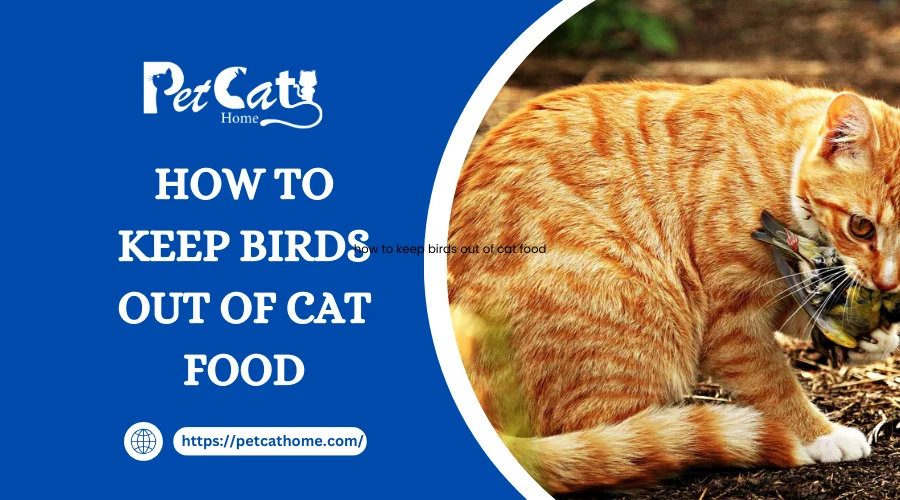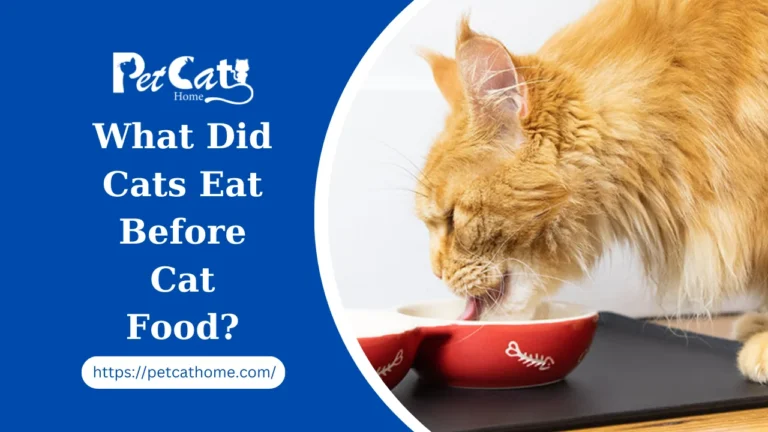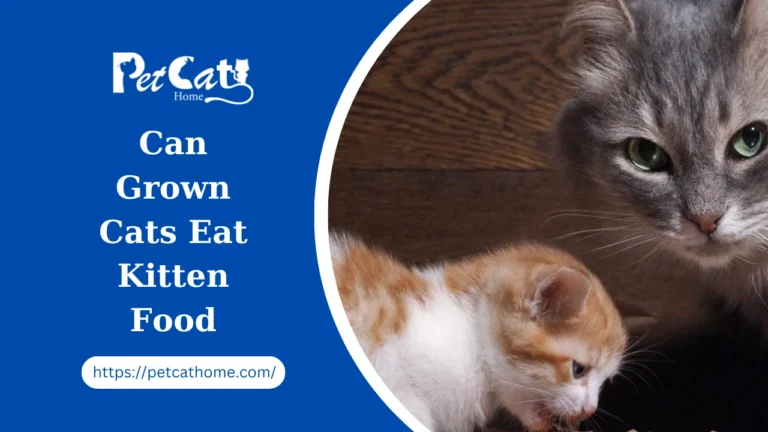how to keep birds out of cat food

It is well known that birds enjoy cat food. Pet owners must take precautions against birds consuming their cats’ food because it’s not only unhygienic but also deprives them of vital nutrients.
By putting the bowl inside the house, you may establish a dedicated feeding place and keep birds out of the cat food. This will make it impossible for birds to get in and eat the food. If you would rather feed your cat outside, enclose the feeding area with a wire or mesh cage to keep birds out and provide your cat access.
Using bird-repellent sprays and sound-emitting devices can be an effective way to keep birds away in addition to these steps. These goods can
be obtained at neighborhood garden centers and pet stores.
By following these guidelines, you can successfully prevent birds from consuming your cat’s food and guarantee that your pet gets the right nourishment without any help. Don’t allow bothersome kee birds to rob your pet of their meals! Even though cats are innate hunters, we don’t want their food bowl to be a bird buffet.
Understanding the Problem
Why Birds Are Attracted to Cat Food
Birds are drawn to the nutritious content and potent aroma of cat food. Because of this fascination, they put their safety at risk when they frequent homes and gardens that sell cat food. Because of the high demand for organic pet food, it is now available without preservatives, which attracts birds more.
Giving organic food to pets and storing the leftovers outside is a trend that may draw in other animals and have unfavorable effects. It is crucial to take the appropriate precautions, such as covering the leftovers or putting them somewhere safe and away from buildings like garages or homes.
Don’t put leftover pet cat food on display outside your home or yard to avoid this dangerous scenario. Make sure it is disposed of properly or stored in containers that are covered so that birds don’t eat it and endanger their lives.
and well-being. Let’s all do our part to preserve the ecosystem by keeping organic materials out of the reach of untamed animals.
It appears that when it comes to the feathery monsters hiding in their cat food, our feline friends might need to start keeping an eye on one other.
Risks Posed by Birds in Cat Food
Cat food attracts a lot of bird species, which could be harmful to them. Feathers and droppings from birds can contaminate cat food with bacteria and diseases that are harmful to cats. Cat food who eat tainted cat food may get diarrhea, vomiting, weight loss, and other ailments. Furthermore, birds may harbor parasites that, if consumed by cats, could be harmful.
Pet owners must be careful about where they store their cat food to reduce these threats. It’s crucial to store the food containers within, properly sealed, as opposed to outdoors, where birds can readily reach them. Furthermore, the risk of contamination can be decreased by routinely washing dishes in hot, soapy water.
Note that not every kind of bird poses a threat. similar risk to the safety of cat food. Generally speaking, dangerous viruses are more likely to be carried by carrion or trash-eating birds than by seed-eating birds like finches and sparrows.
A recent study by researchers at Cornell University revealed that approximately 25% of the prey that free-ranging cats eat is birds. This emphasizes the significance of preventing these animals from consuming cat food that keeps birds contaminated.
Here at last is an answer to the age-old debate between feline and feathery that doesn’t require you to fortify your cat’s food bowl or call the FBI.
Simple Solutions to Keep Birds Out of Your Cat’s Food
Elevated Feeding Stations
Elevated Dining Areas for Cats
Elevating your cat’s feeding station could potentially deter birds from stealing their food. Here are four ideas to improve the eating space for your cat:
- utilizing a feeder with height-adjustable settings
- putting the food bowls atop a countertop or table that is pet-friendly
- putting in wall-mounted shelves made especially for cat food
- Constructing a homemade raised feeding station out of PVC pipes and wood
Try situating your cat’s food location close to shrubs or other foliage to further deter birds by giving them a path of obstruction.
Unbeknownst to many, feeding stations can also help cats by relieving neck strain and avoiding digestive problems that arise from eating with their heads bent. (Refer to PetMD)
You may make sure your cat eats without interference from birds and maintain their comfort and health by elevating their eating place using one of these techniques.
Use a cover that is so strong that even the CIA would be amazed to keep hungry birds away from your cat’s food.
Use of Protective Covers
Placing Obstacles in the Way of Birds Getting to Your Cat’s Food
Using protective covers is a good technique to keep birds away from your cat’s food. In addition to deterring birds, a barrier can help ensure food safety and freshness.
- Select a cover made especially for pet food bowls.
- Covers with weighted edges are less likely to blow away in the wind and are more stable.
- Foodstuffs with airtight and sealable lids might have their shelf life extended.
- Choose covers for wet food that are both secure and ventilate well.
- It is simpler to keep an eye on how much food is remaining in the bowl when the coverings are transparent.
Maintaining optimum efficacy necessitates frequent cover cleaning. Placing the bowl on a pedestal table or another elevated surface is also a good idea.
Pro Tip: Steer clear of using homemade covers made out of upturned bowls or plates since they might not offer sufficient protection and might even spill or topple over.
Control the timing of your cat’s meals to prevent them from becoming a bird buffet. This will help to keep the feathered freeloaders away.

Timing of Feeding Times
Timing and Frequency of Cat Feeding
Provide a consistent feeding schedule for your cat to deter birds from stealing their food. Maintaining uniformity lessens the chances for outdoor creatures to forage. When is the best time to feed them?
- To better control pests, think about feeding twice a day (in the morning and the evening).
- After meals, shift the bowl inside or feed indoors.
- Keep an eye on feeding schedules and serve food in smaller portions to prevent food waste.
- If your cat tends to leave food in their bowl for too long, you may need to adjust their feeding schedule.
- Throughout the day, provide lots of water to promote hydration.
- Employ a time-controlled automatic feeder to establish limits and maintain consistency throughout mealtimes for your pet.
Most importantly, when feeding, pay attention to the time of day. If birds are most active in the mornings and early morning feedings draw them in, wait until midmorning.
To help with this endeavour, consider positioning feeders distant from your home or high above the ground; birdfeeders atop trees or attached to detachable poles may deter cats from approaching them.
Lastly, clear away any remaining food as soon as you finish eating so that scavengers like birds won’t be able to find anything tasty to eat.
We may contribute to the safety and health of our cats by regulating feeding schedules, handling leftovers, and using best practices for outside wildlife!
Who needs a bird feeder when you have a cat dish full of kibble?
Distracting Birds with Alternative Food Sources
Bird Diversion through Alternative Food Sources
Cats are foodies, but birds are also often drawn to food. For those who own pets and wish to maintain their feline companions in good health and nutrition, this can often be a source of frustration. Providing alternate food sources for birds is crucial to preventing this issue.
Here are a few Easy Ways to Divert Birds with Different Food Sources:

- Place a bird feeder away from where your cat usually eats.
- Plant bird-attracting, cat-friendly plants away from your cat’s food source.
- A distinct space set off from your cat’s eating area should be set aside expressly for feeding wild birds.
- Toss old or leftover bread or cereal for birds as an alternate food source.
- Place birdbaths throughout the yard or garden’s perimeter.
- Invest in bird feeders made specifically to keep larger birds out of reach.
When utilizing these substitutes, there are certain particulars to take into account, such as selecting plants that are safe for both cats and wild birds. It’s also important to place the main feeder in a shaded area and make sure that only little animals may access it.
Are you prepared to block birds with extreme precision for your cat’s food?
Advanced Solutions to Keep Birds Out of Your Cat’s Food
Motion-Activated Sprinklers
With the use of technology that detects motion and triggers a sprinkler system, this solution is intended to assist cat owners in keeping birds away from their pet’s food. When using this solution, keep the following four things in mind:
- The motion-activated sprinklers were created with outdoor use in mind.
- Sprinklers are installed in certain locations—such as the vicinity of feeding stations or garden areas—where bird activity has been seen.
- When the sprinklers are turned on, they shoot out a short burst of water that efficiently scares and deters birds without hurting them.
- It is possible to modify the sprinkler activation’s sensitivity and duration to suit individual requirements.
It’s crucial to remember that motion-activated sprinklers have additional advantages. By focusing solely on the areas that are needed, they may efficiently defend plants from common garden pests like rabbits and squirrels while using less water.
Rather than placing the motion-activated sensors at random, it is essential to properly align them with the patterns of bird movement for optimal results. This will be very effective, particularly when used in conjunction with other tried-and-true bird deterrents.
True story: Shortly after the motion-activated sprinkler system was installed, a customer noticed an incredible 90% drop in bird activity on their property. Without the need for deadly workarounds, the device continues to be a useful option for outdoor backyards that require bird management.
Ultrasonic bird repellents: nothing communicates “remain away from my cat’s food” more effectively than loud noises that are audible exclusively to birds.
Ultrasonic Bird Repellents
High-frequency sound devices or Ultrasonic Bird Repellents are a popular approach to keep birds away from your cat’s food by utilizing cutting-edge technology to improve bird management.
Birds can hear the high-pitched sounds that these devices produce, but humans cannot.
Birds get uncomfortable, confused, and disoriented due to the unpleasant noise, which deters them from coming to your yard or bird feeding stations.
Effective and free of noise pollution and other negative effects on wildlife, vegetation, or the environment are the advantages of using ultrasonic bird repellents.
Ultrasonic sound waves, sometimes referred to as electronic pest control systems, have been utilized to ward off rodents and insects for more than 50 years. This more recent use of the technology represents a significant advancement in bird prevention.
The invention of ultrasonic bird-repellent devices began in 1962 when Robert Timm, an inventor, submitted a patent for a “Sonic Repellent Device” that used high-frequency sounds to scare away birds. Since then, the technology has advanced significantly and is now widely used in many different contexts.
And lastly, a natural bird deterrent for your cat’s food can be made out of that eerie scarecrow in your neighbor’s yard.
Natural Bird Repellents
Preserving Wildlife Birds from Eating Your Cat’s Food
Natural bird repellents are practical ways to maintain the cleanliness and safety of your cat’s food. By discouraging or repelling birds from the food dish, these repellents function. These five all-natural bird repellents are available for use:
Hang a mirror, CD, piece of aluminum foil, or any other reflecting object next to the food bowl.
Spice Up Their Diet: You can discourage birds and increase your cat’s intake of nutrients by adding red pepper flakes to their food.
Scare them with Sound: To keep birds away from congregating close to the feeding spot, use wind chimes or a dog whistle.
Make an obstacle course: To impede birds from accessing the feeding spot, place branches, long grass, and shrubs.
spray the Area: Gently spray the feeding zone with water. In most circumstances, this will produce an uncomfortable atmosphere that birds will avoid.
It is crucial to remember that based on the region and kind of bird species, different tactics might be more effective for different cat owners.
It’s also advisable to eliminate any remaining food as soon as your cat has done eating. It is best to feed during the daytime because nocturnal creatures, such as bats and owls, may readily detect inside lights at night.
Keep wild birds from spoiling your cat’s food! Today, give these organic bird repellents a try.
Maintain the safety and satisfaction of your kitty without sacrificing their access to food.
In conclusion, although keeping birds out of your cat’s food may seem difficult, these cutting-edge methods will allow your furry buddy to eat without being bothered by feathered diversions.
Wild birds congregate in regions where there is food. Additionally, if you feed your cat outside, don’t be shocked if the birds quickly start pecking at the poor cat’s food bowl. It’s crucial to understand how to prevent birds from consuming cat food because having access to pet food can be problematic for both you and your cat as well as the bird.
Birds are infamous for carrying a wide range of illnesses. Parasitic worms pose the greatest hazard to your cat and can be challenging to cure in the future. In addition, the most common cause of food illness in cats is Salmonella, which birds can introduce into their food. For the same reason, you ought to keep other animals and birds away from your pet’s food bowl. Please read this article about keeping raccoons.
6 Tips to Keep Birds Away From Cat Food
If the birds continue to nibble on your cat’s outside food bowl, you will need to take action to chase them away. The following advice is very beneficial:
1. Install visual deterrents
If the birds are unable to get your cat’s food in the first place, they cannot feed on it. Unwanted birds can be successfully scared off using visual deterrents such as imitation snakes, owl sculptures, bright decorations, and scare recordings. As some birds are intelligent enough to distinguish between a real threat and a phony one, make sure you move or rotate these.
Another option is to cover your cat’s bowl with glossy tape. To keep the birds away, hang a few strips close to the cat’s feeding area.
In addition, I would advise you to put bird spikes in the areas where the birds usually sit. By doing this, you’ll keep other birds away from your home and their attempts to access the cat food, including bread and other items.

2. Play predator sounds
Instead of ruining the appearance of your garden, you can play the sounds of predators. A hawk’s cry is sufficient to scare off a group of birds. A bird’s distress call might also be used to scare off particular species.
Ultrasonic repellents are used by other pet owners. The issue here, though, is that your cats can hear the bothersome frequency. Your cat can stop eating from its food bowl if you use this. Sometimes, a radio’s sound is sufficient to frighten off birds. Though it’s not always a guarantee, birds can be deterred by the sound of talking people on the radio.
3. Opt for an enclosed feeding station
Installing an enclosed feeding station is a good idea if the birds in your region are invasive. Your cat can simply open the swinging doors of these food stations. In this manner, your cat can enter the house to eat while the birds stay outside.
You can purchase a commercially built model or construct your own feeding station at home. Alternatively, you may buy an enclosure for a litter box and utilise it as a feeding station. Find out how to get rid of cat litter here.
4. Remove leftovers
As soon as your cat has eaten, you should take the leftover food out of its mouth. By doing this, the birds won’t have an opportunity to scavenge anything your cat has left behind. As the food’s aroma may still draw birds and other wild creatures, be careful to grab the bowl.
Feeding your cat for free is not the best option if you have birds in your home. You would need to keep an eye on your cat as it ate unless it had access to an enclosed feeding station.
how to keep birds out of cat food
How can I prevent my cat’s food from being eaten by birds?
The greatest defense against birds stealing your cat’s food is to put the dish somewhere they can’t get to, like inside your house or on an enclosed porch.
Which sort of bowl works best to prevent birds from consuming cat food?
The best way to prevent birds from eating your cat’s food is to use a covered or domed bowl. Your cat can still access the food, but the cover will keep birds from landing on it.
What additional methods are there to prevent birds from consuming cat food?
You can also use bird repellent spray or hang foil strips or shiny objects near the food bowl to deter birds from eating your cat’s food. Another way to keep birds away is to keep your outside feeding location clean and clear of any spilled food.
Can eating birds’ food harm my cat?
No, when birds eat cats’ food, they do not pose a threat to them. To make sure your cat is getting enough nutrition, you might need to change its diet if birds are frequently consuming your cat’s food.
If I try to stop birds from eating my cat’s food, what should I do?
Move the feeding station to a more protected spot or use a different kind of bowl or food container if birds are persistent in trying to get to your cat’s food.
Conclusion
Birds are frequently a cause of concern when it comes to the safety of cat food. Use specialized feeders or locate feeding stations in safer locations as preventative steps to avoid this problem.
To deter birds from scavenging nearby, keep the feeding area tidy. Maintain the space clean regularly and remove any food remnants that could draw in birds and other wildlife. As a natural repellent for birds, adorn the space with real or artificial plants and flowers.
For best results, enclose the feeding zone with mesh wire netting to prevent access. This kind of physical barrier will keep birds out while shielding your cat’s food supply from other wildlife that could pose a threat.
Pro Tip: Make use of puzzleIf you keep cat food feeders for your furry pals, birds can often be a cause of difficulty. These unusual gadgets can deter scavengers from obtaining uneaten kibble while encouraging good behavior during meals.



